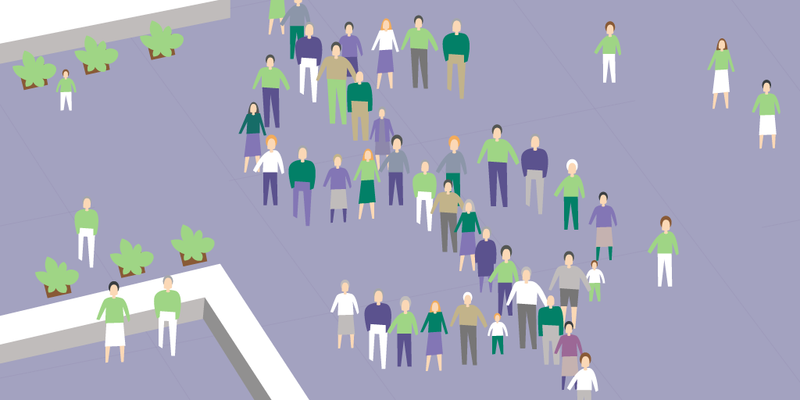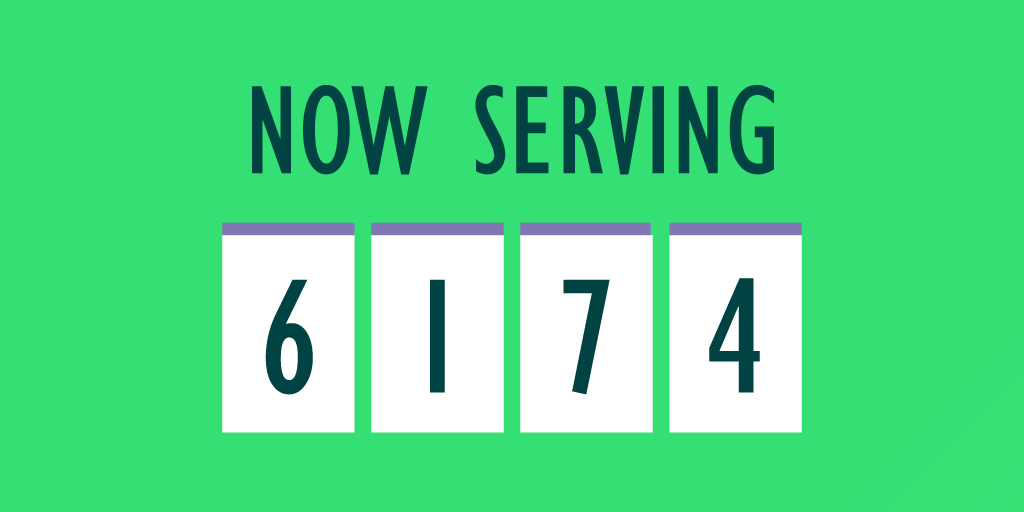There’s no arguing with this bold idea that queues suck. Nobody likes them, nobody is ever excited to be in a queue, and nobody looks forward to them.
There also something that's rarely discussed about queues — their enormous cost.
We kick off this article with a lofty ambition — to put a dollar value on queues, and find out how long waiting impacts the bottom line.
Already know all about the disastrous effects of mismanaged queues? Then sign up for a free 14-day trial of Qminder, and start providing great queueing experience right now.
Customer queues: a time sink
How much time do we spend in queues? Half an hour a week? An hour?
I hope you’re sitting down.
Turns out, Americans spend a staggering 37 billion hours waiting in line each year. Yes, that’s billion with a capital B.
Divided by the US population, this gives us slightly over 113 hours per person per year spent in queues. This number includes elderly, infants and bed-ridden people.
The queuing situation isn’t much better overseas, either. According to the How Long Does It Take To Lose Your Customer report, the average Brit now spends one year, two weeks and a day of their lives stuck in shop queues.
As the length of time spent in queues grows longer, the customers’ patience grows shorter:
25% would only wait a maximum of two minutes
59% would wait no longer than four minutes
73% would abandon their purchase if they had to queue for more than five minutes.

Even UK shoppers, renowned for their tolerance of queues, consider nine minutes long enough to make them reconsider a purchase and walk out from queues more than seven people deep.
86% of Brits say they avoid stores if they perceive the queue to be too long
83% of shoppers consider fast moving queues an essential part of the customer experience
76% say stores should be doing more to reduce queues in busy periods
But even when individual queues are small, they add up to a serious time-sinker: the average shopping trip includes 20.2 minutes of queuing in total.
Negative queuing experiences have a serious impact on customers’ psyche.
27% of consumers get annoyed by fellow shoppers when queuing, and 19% of shoppers have even had an argument with a partner or friend in a queue.
The top complaints when queueing? People unfairly cutting in line, saving the spot for others, and… couples making public displays of affection.
Oh, the humanity! The queues are so bad, they are turning us into grumpy old people who hate everything nice and everyone young.
The impact of a lack of queue management on brand loyalty
Slow-moving queues cause not only shopper frustration but may also affect brand loyalty:
74% would shop in a competitor’s store if they perceive the queue time to be quicker
70% would be less likely to return to shop again if they had experienced long waits, researchers found.
Being able to complete a purchase quickly has a significant effect on how customers view a retailer. 56% of consumers say fast payment and reduced queuing is critical to “positively influencing their perception of a retail brand”.
Raj Parmar, Head of Mobile Solutions at Box Technologies, explained the results of their research:
“Today’s shopper increasingly expects service to be instantaneous and, as a predominant cause of abandoned purchases, retailers can’t afford to ignore the cost – both to revenues and the impact on brand loyalty – of lengthy queues in-store.”
This reflects what we at Qminder have been saying for years: Creating a frictionless customer journey play a big part in converting casual shoppers into loyal customers.
Poor customer queuing and lost revenue
Queues by themselves don’t have a price tag, but it doesn’t mean that they don’t come at a cost to companies. Whereas for customers, queues mean a waste of time, for companies it’s all about missed opportunities.
Missed revenue, to be precise.
Long queues are among the chief contributors to lost store revenue, behind only out-of-stock items. The latter is costing UK retailers up to £14.8 billion each year, while the former up to £11.3 billion.
Another research suggests that long queues could be costing UK retailers as much as £3,581 per day in lost revenue. (The estimates are based on a 53% potential monthly revenue loss due to walkouts, with an average daily revenue of those polled at £6,757.)
A research released by Adyen found that long queues are costing retailers up to £12 billion each year in potential sales losses:
£6.4 billion lost by retailers to their competitors
£5.6 billion lost due to customers leaving or deciding to spend less

This can ultimately have a huge impact on the bottom line.
In the past six months alone, almost 66% of British consumers have abandoned their purchase because of long queues, with only 22% returning later to make the purchase. By even the most generous estimations, merely 26% of consumers prefer to wait it out.
In general, queues play a significant factor in determining a customer’s willingness to make a purchase. A 2012 research paper called Measuring the Effect of Queues on Customer Purchases estimates that “increasing the queue length from 10 to 15 customers would reduce purchase incidence from 30% to 27%”, which corresponds to a whopping 10% drop in sales.
Overcrowdedness in general has disastrous consequences. A research called Does a Crowded Store Lead to a Crowded Mind? Crowding and Mental Construal of Product Features (conducted by Ahreum Maeng, University of Wisconsin-Madison) found that a “socially crowded environment leads people to think more concretely and lowers willingness to pay for a product”.
That’s why we are subconsciously trying to minimize our interactions with crowded places. When we see a suboptimal queue that exceeds the length we would otherwise tolerate, we often decide to balk (read more about balking behavior in queues here).
What’s true for Europe is true for Asia — or all across the globe, really. In Singapore, retailers incur over $1.6 billion a year due to mismanaged queues. 89% of Singaporean shoppers have left a store in the past six months because the queue was too long:
34% did not attempt to purchase the item again
27% purchased a similar item from a different retailer
Similarly, retailers in Hong Kong lose up to $2.35 billion because of shoppers discouraged by long queues. $1.26 billion is lost explicitly due to long wait-to-pay times:
$1.09 billion (~87%) attributed to shoppers choosing another venue
The remaining $170 million (~13%) attributed to shoppers deciding not to make any purchases at all

Globally, negative shopping experiences are costing retailers an estimated $71 billion in abandoned sales per year. As we’ve already seen above, a huge part of this lost revenue is due to inadequate queuing strategies employed by retailers.
This is why people by and large turn to online shopping. 34% of Brits prefer to shop online for almost everything, with 38% of those citing waiting in long queues as the primary reason they don’t shop in stores.
Over 75% of shoppers say that queuing to pay for a product is the worst part of the in-store experience.
Queues negatively affect visitor experience in most industries, but especially retail. Supermarkets are deemed to be causing the most queuing troubles, followed closely by fashion outlets and DIY stores. In all three, mismanaged queuing results in poorer revenue results.
In short, long waiting times are costing you sales, and you need to do something about it.
A queuing solution to queuing troubles
The percentage of customers using online shopping is increasing every year. Consumers take advantage of the convenience, the choice available, the ability to compare prices, and of course, the lack of queues.
Traditional brick-and-mortar retailers can hardly compare. Therefore, to retain their increasingly pickier customers, they need to start providing the ultimate in-store customer experience — starting by eliminating the queuing frustration that is now closely associated with retail.
As part of the How Long Does It Take to Lose Your Customer report that we mentioned earlier, shoppers have been polled to find ways in which retailers might improve the customer experience:
24% say retailers should offer extra loyalty points for those enduring long queues
21% propose rewarding customers with additional promotions, such as a free cup of coffee
10% are in favor of a fast track queue for VIP customers during busy periods

From the retailer end of things, the need to streamline the purchasing process and reduce queues pushes stores to adopt self-service technologies — from self-scanning checkouts to handheld price scanners.
No on-location shopping experience these days is ever complete without a digital retail queue management system. Your customers can register themselves, saving you the headache and time, the real-time tracking of queue status gives them a better estimate of wait times, and automatic SMS notifications make sure they wouldn't miss their turn even if they don't decide to stay in your waiting area.
When it comes to queuing, the key is to offer as much transparency as possible. The more your customers know about what to expect, the less anxious they feel. And the less anxious they feel, the better your experience looks like.
Additional benefits of a queue management system
Reducing queues is not only about freeing customer time; it’s about making sure the customers use their free time that mutually benefits them and you.
Consider for a moment Parkinson’s Law.
In 1955, historian Cyril Northcote Parkinson came up with a humorous law that was based on his experience in the British civil service. The law stipulates that “Work expands so as to fill the time available for its completion”.
Initially, the law related to bureaucracies (“If something must be done in a year, it’ll be done in a year”). Since then, this principle has been appropriated by sociologists to explain, among other things, how an increase in prison capacity leads to greater incarceration rates.
How does Parkinson’s Law relate to reducing queues?
Liberation of resources results in reinvesting these same resources back into the original context. That is to say, if you free up customers’ time by reducing wait times and taking the frustration out of the picture, guess where they will spend this free time.
That’s right, they will spend it at your store — either window-shopping or looking at potential purchases for later. This leads directly to a huge increase in sales through upselling, cross-selling, promotions — you name it.
Every queue that causes complaints or balking is a missed sales opportunity. In other words, solving queues helps you not only not lose revenue, but also maximize it.
I hope we've managed to beat the lesson: queues are a costly consequence of poor planning. If you don't want to miss out on all the revenue opportunities that poor queuing denies you, get yourself a good queue management system — like Qminder.
Research the different pricing plans of Qminder to find the offer that suits your demands and business specifications the most. Or, you can try out Qminder for free for up to 14 days — with no features cut and no strings attached — and decide what you want later.






